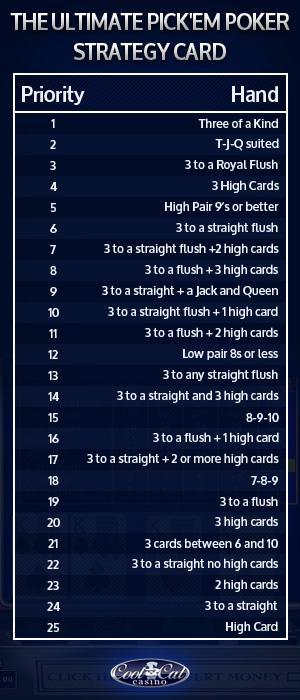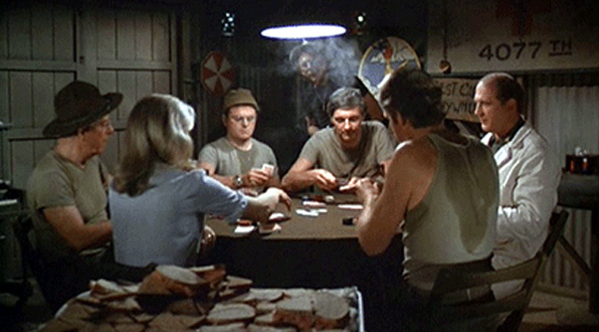GUIDE TO POKER STRATEGY
Poker is a family of cards games that involve both strategy and chance in order to win big. The general maxim of poker strategy is that it is easy to learn and difficult to master. Various poker games rely on game specific strategies, below is a basic and general guide to poker strategies and psychology that will improve your gameplay and pay out in any variation of poker.

Fundamental Theorem of Poker
The Fundamental Theorem of Poker, first articulated by professional American poker player David Sklansky, rests on the concept that poker is a game of that forces you to make decisions with limited information. Essentially, the theorem states that whenever you play your cards as if you knew what your opponents had in hand, you gain. Or, if they play their hand in a manner that is different than if they could see your cards, you gain. Conversely, if you play your hand as if you do not know your opponent’s hand, they gain, and if they play their hand as if they know your hand they also gain.
HOW A VIDEO POKER STRATEGY CHART IS ARRANGED The strategy charts for all non-wild card games are organized the same way. The hand with the highest average return goes at the top of the strategy. Poker strategy tips and tutorials for beginners and advanced players. Improve your skills and learn from experts about Texas Holdem strategy other Poker variants at PokerNews.com.
Omaha Poker Strategy Guide
Thinking and Doing: How to Become a Winning Poker Player US Online Poker is a Long-term Proposition. On top of digesting the theoretical concepts we’ve outlined in our main. Go Against the Grain. General online poker theory dictates that playing aggressively is a winning strategy.
Therefore, decisions made in poker are based on their expected payoff, if you gain or if you lose, using the incomplete information you have.
This concept is why bluffing is a valuable tool. If you can trick your opponent’s into playing for your hand, you can increase your chances of winning. Bluffing is discussed in greater detail below.
Pot Odds & Probability
This is one of the most central concepts of developing poker strategy. Pot odds is defined as the ratio of pot size to bet size needed to remain in the game. For example, the pot is $50 and a player must call $10 to stay in. Their pot odds are 5 to 1, their winning odds must be greater than the pot odds for a positive expectation. So, if there are four players their odds are 4 to 1 (basically), therefore their odds of winning is greater than the pot odds and they should call the $10.
Implied odds, however, are different than pot odds. They do not rely on the size of the pot for that hand, but rather the expected pot size at the end of the hand.
Bluffing & Slow-playing
Bluffing and Slow-playing are forms of deception to encourage a player to play their hand differently than they would if they could see the deceiver’s hand. Sklansky believes that winning at poker rests more on how successfully you can get your opponent to change their style of playing than the cards you hold.
Bluffing is used by players with weak hands in attempts to get other players. with potentially stronger hands, to fold. There is also the semi-bluff, which is used in poker games where players have the chance to improve their hands. Players may bet high on their hand to force players with weak hands to fold while they improve the strength of their hand (and odds of winning the pot).
Slow-playing is essentially the opposite of bluffing. If a player has a strong hand, they may choose to check or place small bets, to increase the pot by forcing players with weak hands to raise.
Psychology Basics
The most effective way to develop poker intuition is to play actively, meaning play the game and pay attention to all your opponents. This is the best way to develop intuition and pick up on various “tells.” There are a couple of standard tells that demonstrate the opponent is feeling stressed, this could be looking up or looking at something random around the room, like fixing your gaze at a chair ahead of you. Typical signs of nervousness, for example twitching, tapping feet, looking around or at a watch, are possible tells an opponent is bluffing. Tells are most often displayed during betting.
Tells are most often displayed during betting. Examine your opponents for their personal tells. However, you cannot play with a stranger and automatically acknowledge when they bet with a certain hand they are bluffing, or something of the like. This is a sense that is sharpened with practice or background knowledge of the opponent(s).
Players with strong hands tend to be more focused in the game and readily examine their opponents and their hand. They also will make attempts to blend into the game and not draw attention to themselves. This can be done by staying still and making safe bets.
Players with weak hands tend to be more outgoing during play; they are talking, moving, smiling, or laughing. Weak raises can also be a tell, especially if conjunction with the previously listed behavior, that a player has a weak hand. Generally, these tells will apply to new and amateur poker players. Professionals tend to have balanced play or employ tells in reverse.
Position
The position is in reference to where players are seated around the poker table and the outcome of this arrangement strategically.
Players that are forced to bet first or second typically need stronger hands so they can match the bets of later players. Being sat later in the betting rotation allows players to respond to the earlier players, giving them an automatic advantage.
Reasons to Call
- Conceal hand strength
- Set-up a bluff or long-ball bluff
- Change pot odds
- Avoid another player re-raising or being forced to re-raise
Reasons to Raise
Full Tilt Poker Strategy Guide

- Increase value of pot if you have a strong hand
- Force other players out with weaker or stronger hands
- Bluff or Semi-bluff
- Earn a free card (applies only to poker games that allow you to improve your hand)
- Learn about opponent’s hands by their reactions (calling, folding, and re-raising)
Types of Play
Loose players stick with their hands, even if they are weaker, and tend to play more hands. Tight players play fewer hands because they fold more often if their hand is weak or somewhat weak. Bluffing in loose games or with loose players is less effective because they generally will not fold. Bets in loose games are typically lower and the payout is less. The reverse applies to tight games or players.
Play can also be aggressive, meaning the player is actively raising and betting, whereas passive play is generally reliant on calling and checking.
Hand Reading & Leveling
Hand Reading is a process of narrowing down the possible hand your opponent has based on their actions throughout the game and the order in which they happened. You are not trying to literally determine what their hand is, but rather a range of what it could be. This can also be done in reverse, thinking of the anti-range, as in what cards they don’t have.
Leveling, as referred to as multi-level thinking, is a strategy that focuses on considering what other player’s think about all the hands. If thinking about what your opponent has in hand is level one, thinking about what they think about other hands is level two. This includes thinking about what opponents think about another opponent’s hand and their own.
REFERENCES:
https://en.wikipedia.org/wiki/Fundamental_theorem_of_poker
https://en.wikipedia.org/wiki/Poker_strategy
http://www.pokerlistings.com/zach-elwood-explains-why-psych-experts-get-poker-tells-wrong
https://www.pokerstars.com/poker/strategy/
https://www.pokernews.com/strategy/other-hand-reading-tools-considering-an-opponents-anti-range-28642.htm
Strategy Guide for Beginners, Intermediate, and Advanced Players
Beginners – We all start somewhere right? The beginner section below outlines many of the basic concepts and fundamentals beginners should learn first before moving to any of the advanced topics. If you’ve never played a single game of poker, we suggest you check our poker rules guide which provides instructions to each of the games supported in our articles. Once you’ve learned the overall structure, you can begin reading a few of our key articles for beginners, such as Essential Skills, Bluffing and Introduction to Razz Poker.
Intermediate – Intermediate players are somewhere in between the beginner and the advanced. Not exactly a losing player but not a winning player either. If you’re the type who “breaks even” more than anything, the Intermediate section may be the perfect spot for you. This area covers some of the more utilized skills such as pot odds, implied odds and even how to play from different streets in draw games.
Advanced – Advanced players have the basics and intermediate skills down to a science. Normally they are winning players and if this happens to be you, we have a number of articles which may help in further developing or fine tuning a few of the areas you’re working on.